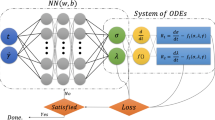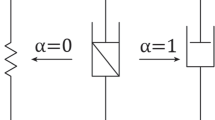Abstract
This study introduces the Constitutive Neural Network (ConNN) model, a machine learning algorithm that accurately predicts the temporal response of complex fluids under specific deformations. The ConNN model utilizes a recurrent neural network architecture to capture the time dependent stress responses, and the recurrent units are specifically designed to reflect the characteristics of complex fluids (fading memory, finite elastic deformation, and relaxation spectrum), without presuming any equation of motion of the fluid. We demonstrate that the ConNN model can effectively replicate the temporal data generated by the Giesekus model and the Thixotropic-Elasto-Visco-Plastic (TEVP) fluid model under varying shear rates. To test the performance of the trained model, we subject it to an oscillatory shear flow, with periodic reversals in flow direction, which has not been trained on. The ConNN model successfully replicates the shear moduli of the original models, and the trained values of the recurrent parameters match the physical prediction of the original models. However, we do observe a slight deviation in the normal stresses, indicating that further improvements are necessary to achieve more rigorous physical symmetry and improve the model prediction.












Similar content being viewed by others
Data Availability
The datasets used and/or analysed during the current study available from the corresponding author on reasonable request.
References
Ahmadi Nadooshan A, Hemmat Esfe M, Afrand M (2018) Prediction of rheological behavior of SiO2-MWCNTs/10W40 hybrid nanolubricant by designing neural network. J Therm Anal Calorim 131(3):2741–2748
Barnes HA (1994) Rheology of emulsions–a review. Colloids Surf, A 91:89–95
Bird RB, Curtiss CF, Armstrong RC et al (1987) Dynamics of polymeric liquids, volume 2: kinetic theory. Wiley
Chen RTQ, Rubanova Y, Bettencourt J et al (2018) Neural ordinary differential equations. In: Bengio S, Wallach H, Larochelle H et al (eds) Advances in Neural Information Processing Systems, vol 31. Curran Associates Inc
Cho K, Van Merriënboer B, Bahdanau D et al (2014) On the properties of neural machine translation: encoder-decoder approaches. Preprint at http://arxiv.org/abs/1409.1259
Elman JL (1990) Finding structure in time. Cogn Sci 14(2):179–211
Esfe MH, Rostamian H, Esfandeh S et al (2018a) Modeling and prediction of rheological behavior of Al2O3-MWCNT/5W50 hybrid nano-lubricant by artificial neural network using experimental data. Physica A: Statistical Mechanics and its Applications 510:625–634
Esfe MH, Rostamian H, Rejvani M et al (2018b) Rheological behavior characteristics of ZrO2-MWCNT/10W40 hybrid nano-lubricant affected by temperature, concentration, and shear rate: an experimental study and a neural network simulating. Physica E: Low-dimensional Systems and Nanostructures 102:160–170
Fischer P, Windhab EJ (2011) Rheology of food materials. Curr Opin Colloid Interface Sci 16(1):36–40
Giesekus H (1982) A simple constitutive equation for polymer fluids based on the concept of deformation-dependent tensorial mobility. J Nonnewton Fluid Mech 11(1–2):69–109
Hochreiter S, Schmidhuber J (1997) Long short-term memory. Neural Comput 9(8):1735–1780
Hyun K, Wilhelm M, Klein CO et al (2011) A review of nonlinear oscillatory shear tests: analysis and application of large amplitude oscillatory shear (LAOS). Prog Polym Sci 36(12):1697–1753
John J, Draper NR (1980) An alternative family of transformations. J Roy Stat Soc: Ser C (Appl Stat) 29(2):190–197
Johnson M Jr, Segalman D (1977) A model for viscoelastic fluid behavior which allows non-affine deformation. J Nonnewton Fluid Mech 2(3):255–270
Kim S, Lee J, Cho KS (2021) Direct conversion of creep data to dynamic moduli using point-wise method. Korea Aust Rheol J 33(2):105–112
Kingma DP, Ba J (2014) Adam: a method for stochastic optimization. Preprint at http://arxiv.org/abs/1412.6980, Published as a conference paper at ICLR 2015
Larson RG (2013) Constitutive equations for polymer melts and solutions: butterworths series in chemical engineering. Butterworth-Heinemann
Lee JCW, Weigandt KM, Kelley EG et al (2019) Structure-property relationships via recovery rheology in viscoelastic materials. Phys Rev Lett 122(24):248003
Lennon KR, McKinley GH, Swan JW (2022) Scientific machine learning for modeling and simulating complex fluids. Preprint at http://arxiv.org/abs/2210.04431
Mahmoudabadbozchelou M, Jamali S (2021) Rheology-informed neural networks (RhINNs) for forward and inverse metamodelling of complex fluids. Sci Rep 11(1):1–13
Mahmoudabadbozchelou M, Karniadakis GE, Jamali S (2022) nn-PINNs: non-Newtonian physics-informed neural networks for complex fluid modeling. Soft Matter 18(1):172–185
Maxwell JC (1867) Iv. on the dynamical theory of gases. Philos Trans R Soc Lond 157:49–88
Mewis J, Wagner NJ (2012) Colloidal suspension rheology. Cambridge University Press
Mujumdar A, Beris AN, Metzner AB (2002) Transient phenomena in thixotropic systems. J Nonnewton Fluid Mech 102(2):157–178
Narimissa E, Wagner MH (2019) Review on tube model based constitutive equations for polydisperse linear and long-chain branched polymer melts. J Rheol 63(2):361–375
Oldroyd JG (1950) On the formulation of rheological equations of state. Proc R Soc Lond A 200(1063):523–541
Park S, Schapery R (1999) Methods of interconversion between linear viscoelastic material functions. Part I-A numerical method based on Prony series. Int J Solids Struct 36(11):1653–1675
Picout DR, Ross-Murphy SB (2003) Rheology of biopolymer solutions and gels. Sci World J 3:105–121
Raissi M, Perdikaris P, Karniadakis GE (2019) Physics-informed neural networks: a deep learning framework for solving forward and inverse problems involving nonlinear partial differential equations. J Comput Phys 378:686–707
Rogers SA (2012) A sequence of physical processes determined and quantified in LAOS: an instantaneous local 2D/3D approach. J Rheol 56(5):1129–1151
Rohrhofer FM, Posch S, Geiger BC (2021) On the pareto front of physics-informed neural networks. Preprint at http://arxiv.org/abs/2105.00862
Rouse PE Jr (1953) A theory of the linear viscoelastic properties of dilute solutions of coiling polymers. J Chem Phys 21(7):1272–1280
Schwarzl F (1970) On the interconversion between viscoelastic material functions. Pure Appl Chem 23(2–3):219–234
Singh PK, Lee JCW, Patankar KA et al (2021) Revisiting the basis of transient rheological material functions: insights from recoverable strain measurements. J Rheol 65(2):129–144
Stickel JJ, Phillips RJ, Powell RL (2006) A constitutive model for microstructure and total stress in particulate suspensions. J Rheol 50(4):379–413
Tarafdar A, Kaur BP, Nema PK et al (2020) Using a combined neural network-genetic algorithm approach for predicting the complex rheological characteristics of microfluidized sugarcane juice. Lwt 123:109058
Warner HR Jr (1972) Kinetic theory and rheology of dilute suspensions of finitely extendible dumbbells. Ind Eng Chem Fundam 11(3):379–387
Zaccarelli E (2007) Colloidal gels: equilibrium and non-equilibrium routes. J Phys: Condens Matter 19(32):323101
Funding
Jin and Ahn declares that this work was supported by the National Research Foundation of Korea (NRF) grant funded by the Korea government (MSIT) (No. NRF-2018R1A5A1024127). Yoon and Park were supported in part by IITP-MSIT grant 2021-0-02068 (SNU AI Innovation Hub), IITP-MSIT grant 2022-0-00480 (Training and Inference Methods for Goal-Oriented AI Agents), SNU-AIIS, SNU-IAMD, SNU BK21+ Program in Mechanical Engineering, SNU Institute for Engineering Research.
Author information
Authors and Affiliations
Corresponding author
Ethics declarations
Conflict of interest
The authors declare no competing interests.
Additional information
Publisher's Note
Springer Nature remains neutral with regard to jurisdictional claims in published maps and institutional affiliations.
Rights and permissions
Springer Nature or its licensor (e.g. a society or other partner) holds exclusive rights to this article under a publishing agreement with the author(s) or other rightsholder(s); author self-archiving of the accepted manuscript version of this article is solely governed by the terms of such publishing agreement and applicable law.
About this article
Cite this article
Jin, H., Yoon, S., Park, F.C. et al. Data-driven constitutive model of complex fluids using recurrent neural networks. Rheol Acta 62, 569–586 (2023). https://doi.org/10.1007/s00397-023-01405-z
Received:
Revised:
Accepted:
Published:
Issue Date:
DOI: https://doi.org/10.1007/s00397-023-01405-z




